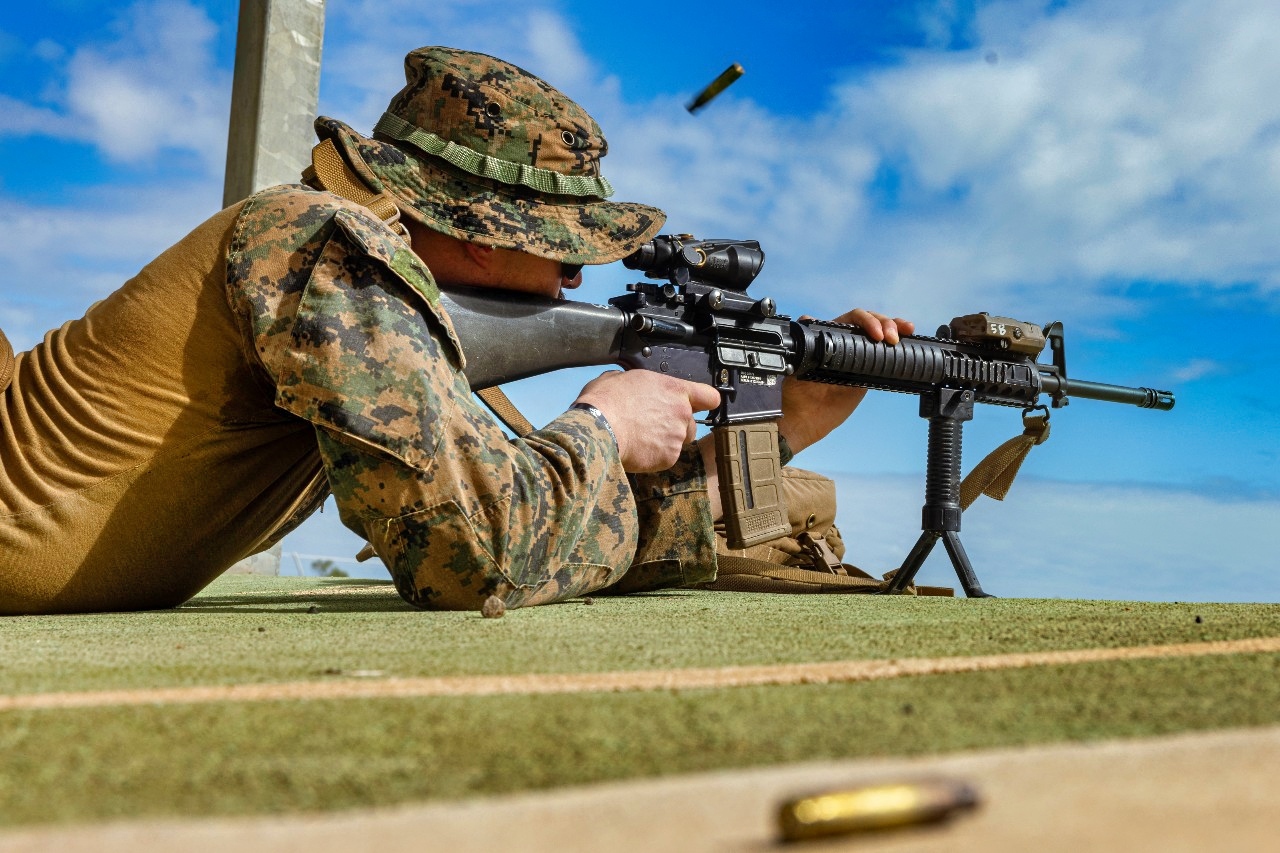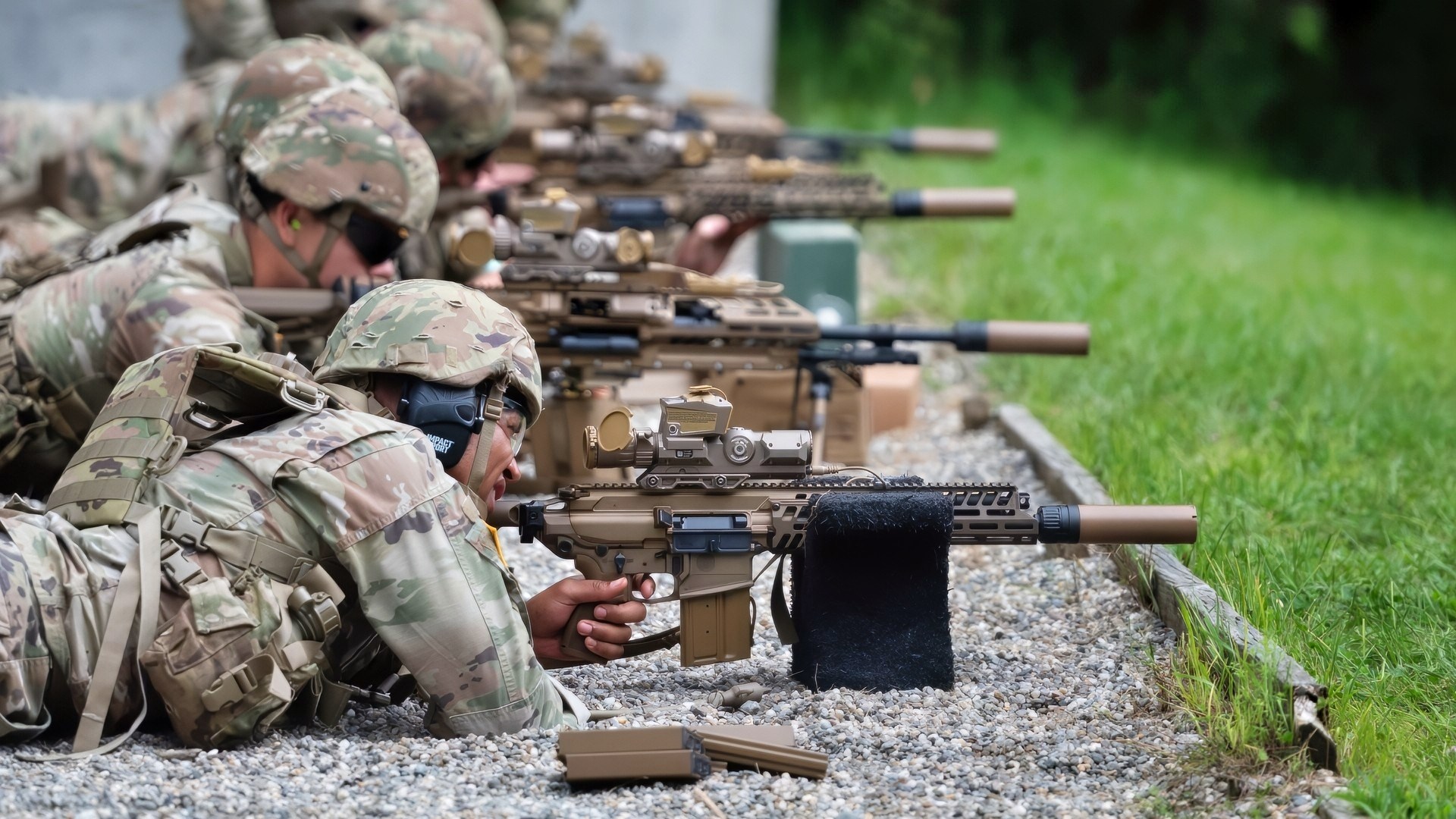Key Points and Summary – The Army’s M7 rifle is finally reaching frontline units, starting with Pacific-focused formations and the 101st Airborne, as the long-planned replacement for the M4 and M249.
-Chambered in 6.8×51mm and paired with the high-tech Vortex M157 optic, the M7 promises better range and armor penetration against near-peer threats like China.

U.S. Marine Corps Sgt. Gabriel Guzman, a platoon sergeant with Combat Logistics Battalion 5 (Reinforced), Marine Rotational Force – Darwin 24.3, fires an M16A4 service rifle during a battlesight zero range at Robertson Barracks, Darwin, NT, Australia, April 23, 2024. A BZO is the elevation and windage settings required to place a single shot, or the center of a shot group, in a predesignated location. MRF-D 24.3 is part of an annual six-month rotational deployment to enhance interoperability with the Australian Defence Force and Allies and partners and provide a forward-postured crisis response force in the Indo-Pacific. Guzman is a native of Illinois. (U.S. Marine Corps photo by Cpl. Juan Torres)
-But it brings tradeoffs: higher weapon and ammo weight, early reliability issues, and a smaller basic load of just 140 rounds versus the M4’s 210.
-SIG Sauer’s “product-improved” lighter carbine and shorter suppressor address some complaints, yet the core debate—more power vs. less ammo—is far from settled.
The M7: The Army’s M4 Replacement Rifle Just Got Lighter
The Army began fielding its newest rifle, the M7, to the 101st Airborne this spring and to line units and Pacific-focused special operations units this fall. This is a half-decade-long endeavor to replace the M4 and the M16 family of weapons that have served the Army since the mid-1960s.
SIG Sauer said, in responding to earlier criticism of the new rifle, that it has trimmed the weight of the weapon down about 10 percent, nearly a pound, to make the rifle comparable to the M4 carbine.
Earlier this year, an Army Captain wrote a scathing critique of the weapon, igniting a firestorm of criticism about the weapon and its manufacturer, SIG Sauer.
Army CPT Braden Trent presented his research on the M7 at the Modern Day Marine exhibition in Washington, D.C., claiming it shows the rifle is inferior to the M4A1.
Short History Of the Weapon
Sig Sauer, which was awarded the contract for the Army’s Modular Handgun System for the M17 and M18 pistols, was awarded the contract for the Army’s Next Generation Squad Weapon program (NGSW), the M7, and the squad automatic weapon, the M250, to replace the M4 and the M249 SAW on April 19, 2022.

M4 Carbine. Image Credit: U.S. Army/Creative Commons.

PACIFIC OCEAN – (Sept. 18, 2021) — Lt. j.g. Dominic Galaz, from Las Cruces, N.M., fires an M4 carbine rifle off the port bridge wing aboard the Arleigh Burke-class guided-missile destroyer USS Mustin (DDG 89) during a live-fire exercise, Sept. 18, 2021. Mustin is currently underway in the U.S. 4th Fleet area of responsibility conducting a series of exercises designed to increase interoperability and build capacity among partner nations. (U.S. Navy Photo by Mass Communication Specialist 2nd Class James S. Hong/Released)
Both weapons will be equipped with the Vortex M157 Next-Generation Squad Weapon-Fire Control (NGSW-FC). This optic integrates advanced technologies, including a laser rangefinder, ballistic calculator, and digital display overlay, into a next-generation rifle optic.
Both weapons are chambered for the new 6.8-millimeter (.277-caliber) round, which the Army describes as superior in lethality and range to common battlefield rounds such as 5.56-millimeter and 7.62-millimeter.
The Army got reports from the troops in the field in Afghanistan that the 5.56 mm rounds of the M4 were ineffective at penetrating body armor or barriers at long distances. The Special Operations Command (SOCOM), Army Marksmanship Unit (AMU), and Army Armament Research, Development, and Engineering Center (ARDEC) have all conducted research and testing and have had a significant influence on the Army in making the switch from 5.56mm to the 6.8mm cartridge.
XM7 Specs
Type Assault rifle
Manufacturer SIG Sauer
Weight 7.6 pounds, 7.3 for the Carbine version
Length 36 in (with suppressor)
Barrel length 10.5 inches (Carbine version)
Cartridge 6.8×51mm (.277 in)
Action Short-stroke gas-operated piston, rotating bolt
Muzzle velocity 3,002 ft/s
Feed system 20-round detachable SR-25 pattern box magazine
25-round detachable SR-25 pattern box magazine (optional)
The M7 is a select-fire, magazine-fed, 6.8mm rifle. Its fully ambidextrous controls are similar to the M4/M4A1 carbine. Some features include a non-reciprocating left-side charging handle and a free-floating MLOK handguard.
The weapon was designed to be suppressed and comes with a quick-detach suppressor, the Sig SLX, which also features a flash-reducing end cap, enhancing its performance.
Pacific Units Getting M7s First, Focus On China
As mentioned above, the Army’s Pacific- and special-operations units got the M7 first.
In Fiscal Year 2025, which began on October 1 last year, the Army started issuing weapons to slated units. After testing and adoption as the primary weapon, the “X” of the XM7 was dropped, and the guns became the M7 and M250.
The contract will require the Army to purchase about 111,428 M7 rifles and 13,334 M250s. Additional stocks will be available for the US Special Operations Command and the Marine Corps if they decide to purchase them.
Issues With A New System Are Not New And Aren’t to the M7
During testing, a unit in the 101st Airborne had issues with the gun jamming and the two-part ammunition casing coming apart. Some of the troops also had problems with the Vortex M157 advanced digital optic. These teething issues are expected with a new weapons system.
When the M16 was first used in Vietnam, there were a myriad of issues with it. Once the Army and Colt had them ironed out, the weapon served for all these years.
One other drawback to the M7? Not every unit will get them. Non-combat MOS’ and non-close combat units will continue to field the M4. Resupply issues may come about in the future with two different calibers.
SIG Sauer’s Changes To The M7
At last month’s AUSA Convention, Jason St. John, senior director of strategic products for the Defense Strategies Group at Sig Sauer, gave TWZ an update on the M7 rifle and the companion 6.8x51mm M250 machine gun.
SIG Sauer has stated that the design was still evolving and that the company will continue to improve it.
Sig Sauer has also been working on a shorter, lighter carbine variant of the M7 for the Army. Sig Sauer did show the lightened “product-improved” M7, also known as the PIE M7, at the biennial Defense and Security Equipment International (DSEI) exhibition in London.
SIG has redesigned and lightened the upper receiver. The barrel was also slightly lightened, and the stock hinge was removed. The original M7 design featured a stock that was both adjustable in length and foldable to one side.
“What we just found is really that the Army and the soldiers have fed back … [that] they’d rather have the weight savings than the folding stock,” St. John said to TWZ. “They aren’t using the folding stock enough to justify that additional weight.”
“We’ve also redesigned our suppressor to make it shorter,” St. John added. “We’ve added a titanium heat shield on it that does two-fold [things].”
SIG and the Army are evaluating whether to keep the standard M7 or switch to the shorter PIE M7 carbine, as the Army did with the M4.
Basic Load Questions Still Persist
One criticism that hasn’t been addressed is the soldier’s basic load. The seven-magazine basic load for an M4 meant a soldier carried 210 rounds of ammunition.
The M7’s seven magazines only carry 140 rounds, a difference of one-third. That is a significant difference. However, the Army believes the M7 and its new cartridge offer improved accuracy, range, and terminal effectiveness, which are worth the added weight and reduced ammunition. Concerns about soldiers being outranged, as well as improvements in adversary body armor, were key drivers behind the M7 program.
Troops love the power and penetration of the 6.8mm round. Some experienced NCOs thought the added weight was negligible.
“…And the round punched straight through it, soldiers said that their M4s were barely putting dents into the steel. 5.56 can theoretically penetrate 12 mm of steel at 100 m….”
The M7 is still in its infancy, and just like the M-16/M4, changes and improvements will continue as input from soldiers comes in.
About the Author: Steve Balestrieri
Steve Balestrieri is a National Security Columnist. He served as a US Army Special Forces NCO and Warrant Officer. In addition to writing on defense, he covers the NFL for PatsFans.com and is a member of the Pro Football Writers of America (PFWA). His work was regularly featured in many military publications.
More Military
Taiwan’s F-16V Fighter Was Built to Fight China’s Air Force
5 Places World War III Could Break Out in 2026
The X-37B Space Plane Is Breaking All the Rules and Makes Chinese Generals Sweat










